Abstract
A new series of Schiff base ligands derived from sulfonamide and their metal(II) complexes [cobalt(II), copper(II), nickel(II) and zinc(II)] have been synthesized and characterized. The nature of bonding and structure of all the synthesized compounds has been explored by physical, analytical and spectral data of the ligands and their metal(II) complexes. The authors suggest that all the prepared complexes possess an octahedral geometry. The ligands and metal(II) complexes have been screened for their in vitro antibacterial activity against bacterial strains, Escherichia coli, Shigella flexneri, Pseudomonas aeruginosa, Salmonella typhi and for antifungal activity against fungal strains, Trichophyton longifusus, Candida albicans, Aspergillus flavus, Microsporum canis, Fusarium solani and Candida glabrata. These assays enabled the identification of the metal complexes as an effective antimicrobial agent with low cytotoxicity.
Introduction
Sulfonamides and their Schiff base-derived compounds are extensively used for antibacterialCitation1, antitumourCitation2, diureticCitation3, anti-carbonic anhydrase (anti-CA)Citation4, hypoglycaemicCitation5, anti-thyroidCitation6 and protease inhibitorCitation7 activities. Many drugs possess modified pharmacological and toxicological potentials when administered in the form of their metal complexes. The most widely studied metal ions in this respect are cobalt(II), copper(II), nickel(II) and zinc(II)Citation8,Citation9. Sulfonamides possessing a free amino group are easily derivatizable, leading to a wide range of biomedical applicationsCitation10. Sulfonamides incorporating imino or hydrazino derivatized moieties also showed effective inhibition of CA isozymesCitation11.
Various biological aspects of the metal complexes exclusively depend on the ease of cleaving the bond between the metal ion and the ligand. It is therefore, important to understand coordination behaviour and relationship of the metals and the ligands in biological systems. In view of the versatile chemistry of sulfonamides as ligand we have started a programCitation12–14 in synthesizing and designing various metal-based sulfonamides and to investigate their structural and biological behaviour. Continuing this work, we herein describe the preparation of two new sulfonamides, 4-{[(Z)–(5-bromo-2-hydroxyphenyl)methylidene] amino}-N-(5-methylisoxazol-3-yl)benzenesulfonamide (L1) and 4-(2-{[(E)–(5-bromo-2-hydroxyphenyl)methylidene]amino}ethyl)benzenesulfonamide (L2) derived from the reaction of sulfamethoxazole and 4-(2-aminoethyl)benzenesulfonamide with 5-bromosalicyl aldehyde, respectively. These sulfonamides have been used for complexation with the cobalt, copper, nickel and zinc ions and then investigated for their in vitro antibacterial activity against four Gram-negative (Escherichia coli, Shigella flexneri, Pseudomonas aeruginosa, Salmonella typhi) and two Gram-positive (Staphylococcus aureus and Bacillus subtilis.) bacterial strains and for antifungal activity against Trichophyton longifusus, Candida albicans, Aspergillus flavus, Microsporum canis, Fusarium solani and Candida glabrata fungal species. The results obtained from the biological studies revealed that all compounds showed moderate to significant activity against various bacterial as well as fungal strains.
Chemistry
The Schiff base ligands (L1) and (L2) were prepared by the reaction of 5-bromosalicylaldehyde with the respective sulfonamide (). All newly synthesized sulfonamides were only soluble in dioxane, N,N-dimethylformamide (DMF) and dimethyl sulfoxide (DMSO). Moreover, characterization has been assessed by microanalytical and mass spectral data. The metal(II) complexes (1)–(8) () of these sulfonamides were prepared in a stochiometric molar ratio as metal: ligand (1: 2)]. Cobalt, copper, nickel and zinc were used as their chloride salts. Physical measurements and analytical data for complexes (1)–(8) are given in and .
Table 1. Physical measurements and analytical data of metal(II) complexes, (1)–(8).
Table 2. Conductivity, magnetic and spectral data of metal(II) complexes, (1)–(8).
Biological activity
In vitro antibacterial activity
All the synthesized compounds were tested against four Gram-negative (E. coli, S. flexneri, P. aeruginosa, S. typhi) and two Gram-positive (S. aureus, B. subtilis) bacterial strains () according to the literature protocolCitation15,Citation16. The antibacterial activity of the Schiff base ligands and their metal complexes was studied in comparison to the standard drug imipenum (). The activity was measured in millimeters (mm) as the zone of inhibition. The data showed that all compounds exhibited varying degree of inhibitory results on the growth of different tested bacterial strains. It was observed from the data that the ligands (L1) and (L2) showed moderate to significant (>16 mm) activity against four Gram-negative and two Gram-positive bacterial strains except strain (b) where weak (<10 mm) activity was observed by both the ligands. The complexes (1)–(8) exhibited overall a significant activity against (a), (c), (d) and (f) bacterial strains whereas, a moderate activity (>10 mm) was exhibited against (b). Similarly, the complexes (2)–(4) and (6)–(8) displayed significant activity (>16 mm) against bacterial strain (e), while the complexes (1) and (5) showed moderate activity (>10 mm) against the same strain. The data showed that antibacterial activity is overall enhanced upon complexation of the ligands ( and ) with the metal ions. It was further observed from the data that the zinc(II) complexes (4) and (8) interestingly were proved to be the most active compounds against all bacterial species.
Table 3. Antibacterial study (concentration used 1 mg/mL of DMSO) of ligands (L1) and (L2) and metal(II) complexes (1)–(8).
In vitro antifungal activity
The antifungal screening of the ligands (L1) and (L2) and their metal(II) complexes (1)–(8) was carried out against T. longifusus, C. albican, A. flavus, M. canis, F. solani and C. glabrata fungal strains () according to the literature protocolCitation16. The data showed that most of the compounds exhibited good antifungal activity against different fungal strains. Ligands (L1) and (L2) exhibitedCitation17 excellent (above 80%) activity against fungal strain (c) while moderate (50–80%) activity was observed against (a) and (c). It was also, observed that both the ligands were inactive and/or showed very weak activity (<50%) against fungal strains (d), (e) and (f). The data further exhibited that the complex (4) showed excellent activity (above 80%) against (c). Moreover, complexes (2), (3) and (8) also showed excellent activity against (d) and similarly (6)–(8) showed excellent activity (above 80%) against fungal strain (e). The complexes (1), (2), (4)–(6) and (8) exhibited moderate activity (50–80%) against (a), A moderate activity of complex (8) was also observed against (b). Similarly, complexes (1)–(3) and (5)–(7) exhibited moderate activity against (c). Complexes (1), (4), (6) and (7) likewise, showed moderate activity against strain (d). A moderate activity was also, observed by the complexes (3) and (5) against (e) and (2) and (4) against (f) fungal strains. All other complexes showed either a weak activity (below 50%) or were inactive. The results of inhibition were compared with the standard drugs, miconazole and amphotericin B. These results conclusively revealed that the zinc(II) complexes (4) and (8), exhibited excellent average antifungal activity (56.5 and 57.67%) () as compared to all other metal(II) complexes against all tested strains. On comparison of the average activity data of the ligands with the metal complexes (), it was found that metal(II) complexes showed greater average activity than the average activity of the ligands. Based on these evidences, a conclusion can be drawn that the antifungal activity is also increased upon coordination with the metal ions.
Table 4. Antifungal study (concentration used 200 µg/mL) of ligands (L1) and (L2) and metal(II) complexes (1)–(8).
Minimum inhibitory concentration
All compounds have shown variable average inhibition against different bacterial strains in the range 13.00 (55.31%) to 21.5 (91.48%) (). The data obtained after preliminary antibacterial screening showed that compounds (2), (4) and (8) were the most active (above 80%) and their average inhibition values were 18.84 (80.17%), 19.84 (84.44%) and 21.5 (91.48%), respectively. These compounds were therefore, selected for antibacterial minimum inhibitory concentration (MIC) studiesCitation18 (). The MIC results of these most active compounds were found in the range, 1.667 × 10−8 to 5.338 × 10−7 M. Among them, compound (4) was proved to be the most active that inhibited the growth of B. subtilis at 1.667 × 10−8 M.
Table 5. Minimum inhibitory concentration (M/mL) of the selected compounds (2), (4) and (8) against selected bacterial strains.
In vitro cytotoxicity
The synthesized ligands (L1) and (L2) and their metal complexes (1)–(8) were screened for their cytotoxicity (brine shrimp bioassay) using the protocol of Meyer et alCitation19. It is revealed from the data reproduced in that two compounds (3) and (7) exhibitedCitation20 effective cytotoxic activity against Artemia salina, while all other compounds were inactive for this assay. The copper complexes (3) and (7) in the present series of compounds, showed LD50 as 6.342 × 10−4 and 6.173 × 10−4 M/mL, respectively. It is remarkable to mention that only copper complexes showed potent cytotoxicity. This activity relationship may help to serve as a basis for future direction towards the development of certain cytotoxic agents for preclinical development.
Table 6. Brine shrimp study of the ligands (L1)–(L2) and their metal(II) complexes (1)–(8).
Results and discussion
Infrared spectra
Characteristic infrared (IR) spectral bands of Schiff base ligands (L1) and (L2) and their metal(II) complexes (1)–(8) are given in and in experimental. IR spectra of uncoordinated Schiff base ligands, generally, showed one broad and one sharp band at 3321–3325 and 1598–1605 cm−1, respectively assignedCitation21 to the v(OH) and azomethine (HC=N) linkage. Furthermore, two bands appearing at 1345 and 1110 cm−1 were correspondingly assigned to the vibrations vasymm(SO2) and vsymm(SO2). In all the metal complexes (1)–(8), the band for azomethine (C=N) linkage was found to be at lower frequency side by 29–36 cm−1 (1565–1569 cm−1), indicating the formation of a new bond between nitrogen and the metal ion. This is further supported by the appearance of a new band at 439–441 cm−1 assigned to the v(M-N)Citation22. The coordination through the hydroxyl-O is revealed by the disappearance of broad bands at 3325 and 3321 cm−1 and in turn, appearance of new bands at 1393 and 1395 cm−1 due to deprotonation and coordination of v(OH) and an establishment of the C-O mode. This is further supported by the appearance of new bands at 529 and 535 cm−1 due to v(M-O) in the metal(II) complexes (1)–(8). The bands at 1345 and 1110 cm−1 present in the spectra of Schiff base ligands due to vasymm(SO2) and vsymm(SO2) were found unchangedCitation23 in the spectra of their metal complexes, indicating that this group is not taking part in the coordination. This is further supported by the unchanged modes of v(S-N) and v(C-S)Citation24,Citation25 appearing at 953–954 and 841–842 cm−1, respectively in the spectra of Schiff base ligands as well as in their metal complexes. All other potential donor sites of the Schiff base ligands similarly, do not participate in coordination as their IR frequencies remain unchanged after complexation.
Proton nuclear magnetic resonance spectra
Proton nuclear magnetic resonance (1H NMR) spectra of the free sulfonamides and their diamagnetic zinc(II) complexes were recorded in DMSO-d6. The 1H NMR spectral data along with the possible assignments is recorded in the experimental part. All the protons due to heteroaromatic/aromatic groups were found in their expected regionCitation26. The conclusions drawn from these studies provide further support to the mode of bonding discussed in their IR spectra. The coordination of the azomethine nitrogen is inferred by the downfield shifting of the azomethine (CH=N) proton signal from 8.9 and 8.91 ppm in the ligands (L1) and (L2) to 9.1 ppm in its Zn(II) complexes. It was further observed that the hydroxyl proton present in the spectra of the ligands at 12.42 ppm disappeared in the spectra of its Zn(II) complexes which were an evidence of deprotonation and coordination of the oxygen atom with the zinc metal ion. All other protons underwent downfield shifting by 0.16–0.31 ppm due to the increased conjugationCitation27 and coordination with the metal atoms. Furthermore, number of protons calculated from the integration curves, and those obtained from the values of the expected CHN analyses agree well with each other.
Carbon nuclear magnetic resonance spectra
Carbon NMR (13C NMR) spectra of the Schiff base ligands and their diamagnetic zinc(II) complexes were also recorded in DMSO-d6. All assignments of the carbon atoms in sulfonamides were found in their expected regionCitation26 and are well-supported by their IR and 1H NMR spectra. Downfield shifting of the azomethine carbon from 160.9 ppm in the spectra of ligands to 162.5 and 162.6 ppm in the spectra of its Zn(II) complexes revealed coordination of the azomethine-N to the metal atom. Similarly, carbons at N-phenyl ring (C1 N-Ph) and Br-phenyl ring (C2 Br-phenyl), being nearer to the coordination sites also showed downfield shiftingCitation27. The spectra further indicated the presence of number of carbons in agreement with the expected number.
Mass spectra
The mass spectral data and main fragments of ligand (L2) and its copper complexCitation28,Citation29 [Cu(L2-H)2(H2O)2] along with their molecular complex ion peaks are given as Figures in Supplementary material ( and ). Mass spectral studies indicated that both the ligands were consistent with their formulations. The observed molecular mass of ligand (L1), C17H14BrN3O4S was 436.0 (calcd. 436.32) and [C13H10NOBr]·+ m/z = 276 was considered as most stable fragment of ligand (L1). Similarly, the observed molar mass of second ligand (L2), C15H15BrN2O3S was 383.0 (calcd. 383.27) and its base peak for fragment [C8H8ONBr]+ was observed at m/z 214. Moreover, it was observed that the mass spectra of metal(II) complexes (1)–(8) were also consistent with the calculated masses of their proposed formulae. The molecular mass of complex (1), C34H30N6O10S2Br2Co was observed at m/z 964.8 (calcd. 965.53). The complexes (2), (3), (4), (5), (6), (7) and (8) have m/z 964.5 (calcd. 965.26), m/z 969.3 (calcd. 970.14), m/z 971 (calcd. 971.98), m/z 858.7 (calcd. 859.47), m/z 858.4 (calcd. 859.23), m/z 863.2 (calcd. 864.08) and m/z 865 (calcd. 865.93), respectively. It is interesting to note that the base peak for all the metal(II) complexes was observed at the same m/z as that of the respective ligands.
Electronic spectra
The electronic spectral data of the metal(II) complexes (1)–(8) are given in . The Co(II) complexes (1) and (5) exhibited well-resolved, low-energy bands at 7297–7361, 17492–17519 cm−1 and a strong high-energy band at 20485–20626 cm−1 which are assignedCitation30 to the transitions 4T1g(F)→4T2g(F), 4T1g(F)→4A2g(F) and 4T1g(F)→4T2g(P) in an octahedral environmentCitation31. A high-intensity band at 29353–29362 cm−1 was assigned to the metal→ligand charge transfer.
The electronic spectra of the Ni(II) complexes showed d-d bands in the region at 10410–10434, 15689–15789 and 26494–26538 cm−1. These are assignedCitation32 to the transitions 3A2g(F)→3T2g(F), 3A2g(F)→3T1g(F) and 3A2g(F)→3T2g(P), respectively, consistent with their well-defined octahedral configuration. The band at 29991–30955 cm−1 was assigned to metal→ligand charge transfer.
The electronic spectra of the Cu(II) complexes () showed two low-energy weak bands at 14981–15156 and 19188–19210 cm−1 and a strong high-energy band at 30356–30382 cm−1 assigned to 2B1g→Citation2A1g and 2B1g→Citation2Eg transitions, respectivelyCitation33. The strong high-energy band, in turn, is assigned to metal→ligand charge transfer. The electronic spectra of the Zn(II) complexes exhibited only a high-intensity band at 28984–29134 cm−1 assignedCitation34 to ligand→metal charge transfer.
Conductance and magnetic susceptibility measurements
The molar conductance values were obtained at room temperature using DMF as a solvent and results are recorded in . The complexes (1)–(8), showed their molar conductance in the range 13.9–18.1 ω−1 cm2 mol−1 indicating their non-electrolytic natureCitation35. The magnetic moment values of the complexes (1)–(8) at room temperature are given in . The observed magnetic moment value for cobalt(II) complexes (1) and (5) was found to be as 4.94 and 4.91 B.M., respectively, consistent with half-spin octahedral cobalt(II) complexes. The magnetic moment values (1.85 and 1.88 B.M.) measured for the copper(II) complexes, (3) and (7) lie in the range expected for a d9-system that contains one unpaired electron consistent to an octahedral geometryCitation36. The measured values, 3.32 and 3.36 B.M. for the nickel(II) complexes (2) and (6) also suggestedCitation37 an octahedral geometry for these complexes. The zinc(II) complexes (4) and (8) were found to be diamagnetic as expected.
Supplementary material
X-ray structure of one of the ligand, 4-(2-{[(E)–(5-bromo-2-hydroxyphenyl)methylidene] amino}ethyl)benzenesulfonamide (L2) has already been publishedCitation38 by us. The bond distances, bond angles, calculated hydrogen atom positions, anisotropic displacement parameters and calculated structure factors can be obtained from the author. Fragmentation pattern of ligand (L2) and its copper complex is also given in Supplementary material.
Conclusions
It has been suggested that the antibacterial and antifungal activity of ligands (L1) and (L2) increased upon coordination. The chelation/coordination process reduces the polarity of metal ion by coordinating with ligands which increase the lipophilic nature of the metal. This lipophilic nature of metal enhancedCitation39–42 its penetration through the lipoid layer of the cell membrane of the microorganism. Further, it has been suggested that some functional groups such as azomethine (–C=N-) or heteroatoms present in these compounds play an important role in antibacterial and antifungal activity that may also, be responsible for the enhancement of hydrophobic character and liposolubility of the molecules.
Experimental
Materials and methods
All reagents, chemicals and solvents used were of analytical grade and were obtained from the suppliers. Elemental analyses were carried out with a Perkin Elmer Analyzer (US model). 1H and 13C NMR spectra of the compounds were recorded with a Bruker Spectrospin Avance DPX-400 using TMS as internal standard and d6 DMSO as a solvent. IR spectra of the compounds were recorded on a SHIMADZU FTIR spectrophotometer. Mass spectra of the compounds were recorded using JEOL MS Route spectrometer in electron impact ionization mode. The melting points were determined with a Gallenkamp melting point apparatus. In vitro antibacterial, antifungal and cytotoxic properties were studied at HEJ research Institute of Chemistry, International Center for Chemical Sciences, University of Karachi, Karachi, Pakistan.
Synthesis of ligand (L1)
To an ethanol (30 mL) solution of sulfamethoxazole (1.02 g, 0.004 moles), 5-bromosalisylaldehyde (0.804 g, 0.004 moles) in ethanol (15 mL) was added with constant stirring. The solution was refluxed for 3 h by monitoring through thin-layer chromatography (TLC). The solution was cooled to room temperature, filtered and evaporated on rotary evaporator. The solid product thus obtained was recrystallized in hot DMF/ether (75% yield). Same method was adopted for the synthesis of ligand (L2).
4-{[(Z)–(5-Bromo-2-hydroxyphenyl)methylidene]amino}-N-(5-methylisoxazol-3-yl) benzenesulfonamide (L1)
Yield 75% (1.36 g); yellow; m.p. 216–218°C; IR (KBr, cm−1): 3325 (OH), 1605 (HC=N), 1342, 1108 (S=O), 953 (S-N), 842 (C-S), 5654 (C-Br); 1H NMR (DMSO-d6, δ, ppm): 2.31 (s, 3H, methylisoxazole), 6.8 (s, 1H, isoxazole), 6.9–7.6 (m, 3H, bromo-phenyl), 7.7–8.2 (m, 4H, N-Ph), 8.9 (s, 1H, azomethine), 8.9 (s, 1H, SO2NH-), 12.42 (s, 1H, OH); 13C NMR (δ, ppm): 12.9 (C methylisoxazole), 95.1 (C4 isoxazole), 118.4 (C3 Br-phenyl), 120.5 (C1 Br-phenyl), 122.6 (C2, C6 N-Ph), 116.0 (C5 Br-phenyl), 128.6 (C3, C5 N-Ph), 134.0 (C6 Br-phenyl), 135.5 (C4 Br-phenyl), 138.2 (C4 N-Ph), 150.0 (C3 isoxazole), 156.4 (C1 N-Ph), 160.0 (C2 Br-phenyl), 160.9 (C=N, azomethine) 169.6 (C5 isoxazole); Anal. Calcd. for C17H14BrN3O4S (436.32): C, 46.75; H, 3.20; N, 9.63; found: C, 46.62; H, 3.49; N, 9.81. Mass spectrum [(electrospray ionization (ESI)] [M]+ = 436.
4-(2-{[(E)–(5-Bromo-2-hydroxyphenyl)methylidene]amino}ethyl)- benzenesulfonamide (L2)
Yield 79% (1.26 g); yellow-green; m.p. 184–186°C; IR (KBr, cm−1): 3321 (OH), 1598 (HC=N), 1344, 1110 (S=O), 955 (S-N), 842 (C-S), 565 (C-Br); 1H NMR (DMSO-d6, δ, ppm): 3.13 (t, 2H, CH2-aromatic), 3.34 (t, 2H, CH2-N), 6.9–7.6 (m, 3H, bromo-phenyl), 7.7–8.2 (m, 4H, N-Ph), 8.91 (s, 1H, azomethine), 9.2 (s, 2H, -SO2NH2), 12.42 (s, 1H, OH); 13C NMR (δ, ppm): 37.5 (CH2-aromatic), 61.3 (CH2-N), 118.4 (C3 Br-phenyl), 120.5 (C1 Br-phenyl), 128.1 (C2, C6 N-Ph), 116.0 (C5 Br-phenyl), 127.2 (C3, C5 N-Ph), 134.0 (C6 Br-phenyl), 135.5 (C4 Br-phenyl), 136.8 (C4 N-Ph), 142.7 (C1 N-Ph), 160.0 (C2 Br-phenyl), 160.9 (C=N, azomethine); Anal. Calcd. for C15H15BrN2O3S (383.27): C, 46.96; H, 3.94; N, 7.31; found: C, 47.0; H, 3.92; N, 7.3; mass spectrum (ESI) [M]+ = 383.
Synthesis of metal (II) complex with 4-{[(Z)–(5-bromo-2-hydroxyphenyl)-methylidene]amino}-N-(5-methylisoxazol-3-yl)benzenesulfonamide (L1)
To a hot magnetically stirred dioxane (15 mL) solution of 4-{[(Z)–(5-bromo-2-hydroxyphenyl)methylidene]amino}-N-(5-methylisoxazol-3-yl)benzenesulfonamide (L1) (0.872 g, 0.002 moles), an aqueous solution (15 mL) of Co(II) Cl2.6H2O (0.238 g, 0.001 moles) was added and refluxed for 2 h. The completion of the reaction was monitored through TLC. The obtained solution was filtered and evaporated to half of its volume through rotary. The concentrated solution was left overnight at room temperature, which led to the formation of a solid product. It was filtered, washed with small amount of dioxine then with ether, dried and recrystallized in hot aqueous-dioxane (2:5). All other complexes (2–8) were prepared following the same method using the respective metal salts as chloride and ligand. Physical measurements, analytical and spectral data of the complexes are given in and .
Zinc(II) complex of (L1) (4)
1H NMR of Zn(II) complex (DMSO-d6, δ, ppm): 2.31 (s, 6H, methylisoxazole), 6.8 (s, 2H, isoxazole), 7.4–7.8 (m, 6H, Br-Ph), 8.1–8.5 (m, 8H, N-Ph), 9.1 (s, 2H, azomethine), 9.1 (s, 2H, SO2NH-); 13C NMR of Zn(II) complex (δ, ppm): 12.9 (C methylisoxazole), 95.1 (C4 isoxazole), 118.4 (C3 Br-Ph), 120.5 (C1 Br-Ph), 122.6 (C2, C6 N-Ph), 116.0 (C5 Br-Ph), 128.6 (C3, C5 N-Ph), 134.0 (C6 Br-Ph), 135.5 (C4 Br-Ph), 138.2 (C4 N-Ph), 150.0 (C3 isoxazole), 158.5 (C1 N-Ph), 162.1 (C2 Br-Ph), 162.6 (HC=N, azomethine) 169.6 (C5 isoxazole).
Zinc(II) complex of (L2) (8)
1H NMR of Zn(II) complex (DMSO-d6, δ, ppm): 3.13 (t, 4H, CH2-aromatic), 3.7 (t, 4H, CH2-N), 7.4–7.8 (m, 6H, Br-Ph), 8.1–8.5 (m, 8H, N-Ph), 9.1 (s, 2H, azomethine), 9.3 (s, 4H, -SO2NH2); 13C NMR of Zn(II) complex (δ, ppm): 37.5 (CH2-aromatic), 61.3 (CH2-N), 118.4 (C3 Br-Ph), 120.5 (C1 Br-Ph), 128.1 (C2, C6 N-Ph), 116.0 (C5 Br-Ph), 127.2 (C3, C5 N-Ph), 134.0 (C6 Br-Ph), 135.5 (C4 Br-Ph), 136.8 (C4 N-Ph), 143.8 (C1 N-Ph), 162.1 (C2 Br-Ph), 162.5 (C=N, azomethine).
Biological screening
In vitro antibacterial
The synthesized sulfonamides (L1) and (L2) and their metal(II) complexes (1)–(8) were screened in vitro for their antibacterial activity against four Gram-negative (E. coli, S. flexneri, P. aeruginosa, S. typhi) and two Gram-positive (S. aureus, B. subtilis) bacterial strains by the agar-well diffusion methodCitation15,Citation16. The wells (6 mm in diameter) were dug in the media with the help of a sterile metallic borer with centers at least 24 mm apart. Bacterial inocula (2–8 h-old) containing approximately 104–106 colony-forming units (CFU/mL) were spread on the surface of the nutrient agar with the help of a sterile cotton swab. The recommended concentration of the test sample (50 μg/μL in DMSO) was introduced in the respective wells. Other wells supplemented with DMSO and reference antibacterial drug, imipenum, served as negative and positive controls, respectively. The plates were incubated at 37°C for 24 h. Activity was determined by measuring the diameter (mm) of zones showing complete inhibition. In order to clarify any participating role of DMSO in the biological screening, separate studies were carried out with the solutions alone of DMSO and they showed no activity against any bacterial strains.
In vitro antifungal
Antifungal activity of all the compounds was studiedCitation16 against six fungal cultures. Sabouraud dextrose agar (Oxoid, Hampshire, England) was seeded with 105 (CFU) mL−1 fungal spore suspensions and transferred to petri plates. Discs soaked in 20 mL (200 µg/mL in DMSO) of all compounds were placed at different positions on the agar surface. The plates were incubated at 32°C for 7 days. The results were recorded as percentage of inhibition and compared with standard drugs miconazole and amphotericin B.
MIC
Compounds containing high antibacterial activity (over 80%) were selected for MIC studies. The MIC was determined using the disc diffusion technique by preparing discs containing 10, 25, 50 and 100 μg/mL of the compounds and applying the protocolCitation18.
In vitro cytotoxicity
Brine shrimp (Artemia salina leach) eggs were hatched in a shallow rectangular plastic dish (22 × 32 cm), filled with artificial seawater, which was prepared with commercial salt mixture and double distilled water. An unequal partition was made in the plastic dish with the help of a perforated device. Approximately 50 mg of eggs were sprinkled into the large compartment, which was darkened while the matter compartment was opened to ordinary light. After two days nauplii were collected by a pipette from the lighted side. A sample of the test compound was prepared by dissolving 20 mg of each compound in 2 mL of DMF. From this stock solutions 500, 50 and 5 µg/mL were transferred to nine vials (three for each dilutions were used for each test sample and LD50 is the mean of three values) and one vial was kept as control having 2 mL of DMF only. The solvent was allowed to evaporate overnight. After two days, when shrimp larvae were ready, 1 mL of seawater and 10 shrimps were added to each vial (30 shrimps/dilution) and the volume was adjusted with sea water to 5 mL per vial. After 24 h the number of survivors was counted. Data were analyzed by Finney computer program to determine the LD50 valuesCitation19.
Acknowledgement
HAZ is grateful to Higher Education Commission (HEC), Government of Pakistan for providing Scholarship under Indigenous PhD Program (PIN 042–160410-PS2-117). The authors are also thankful to HEJ research Institute of Chemistry, University of Karachi, Pakistan, for providing help in taking NMR and mass spectra and also antibacterial and antifungal assays.
Declaration of interest
The authors report no conflict of interest. The authors alone are responsible for the content and writing of the article.
References
- Chohan ZH, Supuran CT, Scozzafava A. Metalloantibiotics: synthesis and antibacterial activity of cobalt(II), copper(II), nickel(II) and zinc(II) complexes of kefzol. J Enzyme Inhib Med Chem 2004;19:79–84.
- Pacchiano F, Carta F, McDonald PC, Lou Y, Vullo D, Scozzafava A et al. Ureido-substituted benzenesulfonamides potently inhibit carbonic anhydrase IX and show antimetastatic activity in a model of breast cancer metastasis. J Med Chem 2011;54:1896–1902.
- Supuran CT. Diuretics: from classical carbonic anhydrase inhibitors to novel applications of the sulfonamides. Curr Pharm Des 2008;14:641–648.
- Supuran CT. Carbonic anhydrases: novel therapeutic applications for inhibitors and activators. Nature Rev Drug Discov 2007;8:167–181.
- Cryer PE, Axelrod L, Grossman AB, Heller SR, Montori VM, Seaquist ER et al. Evaluation and management of adult hypoglycemic disorders: an Endocrine Society Clinical Practice Guideline. J Clin Endocrinol Metab 2009;94:709–728.
- Cooper DS. Antithyroid drugs. N Engl J Med 2005;352:905–917.
- Supuran CT, Casini A, Scozzafava A. Protease inhibitors of the sulfonamide type: anticancer, antiinflammatory, and antiviral agents. Med Res Rev 2003;23:535–558.
- Chohan ZH, Scozzafava A, Supuran CT. Synthesis of biologically active Co(II), Cu(II), Ni(II) and Zn(II) complexes of symmetrically 1,10-disubstituted ferrocene-derived compounds. Synth React Inorg Met-Org Chem 2003;33:241.
- Castillo-Blum SE, Barba-Behrens N. Coordination Chemistry of Some Biologically Active Ligands. Coord Chem Rev 2000;196:3–30.
- Menabuoni L, Scozzafava A, Mincione F, Briganti F, Mincione G, Supuran CT. Carbonic anhydrase inhibitors. Water-soluble, topically effective intraocular pressure lowering agents derived from isonicotinic acid and aromatic/heterocyclic sulfonamides: is the tail more important than the ring? J Enzym Inhib 1999;14:457–474.
- Pastorekova S, Parkkila S, Pastorek J, Supuran CT. Carbonic anhydrases: current state of the art, therapeutic applications and future prospects. J Enzyme Inhib Med Chem 2004;19:199–229.
- Chohan ZH. Synthesis and biological properties of Cu(II) complexes with 1,10-disubstituted ferrocenes. Synth React Inorg Met-Org Chem 2004;34:833.
- Chohan ZH, Shad HA. Structural elucidation and biological significance of 2-hydroxy-1-naphthaldehyde derived sulfonamides and their first row d-transition metal chelates. J Enzyme Inhib Med Chem 2008;23:369–379.
- Chohan ZH, Shad HA, Youssoufi MH, Hadda TB. Some new biologically active metal-based sulfonamide. E J Med Chem 2010;45:2893–2915.
- Chohan ZH. Synthesis of cobalt(II) and nickel(II) complexes of Ceclor (cefaclor) and preliminary experiments on their antibacterial character. Chem Pharm Bull 1991;39:1578–1580.
- Atta-ur-Rahman Choudhary, MI, Thomsen WJ. Bioassay techniques for drug development. The Netherlands: Harwood Academic Publishers 2001:22.
- Chohan ZH, Supuran CT. Structural and biological properties of first row d-transition metal complexes with N-substituted sulphonamides. J Enzyme Inhib Med Chem 2008;23:240–251.
- McLaughlin JL, Chang C-J, Smith DL. In: Atta-ur-Rahman, ed. Studies in Natural Products Chemistry, “Bentch-Top” Bioassays for the Discovery of Bioactive Natural Products: An Update, Structure and Chemistry (Part-B), Vol. 9. The Netherlands: Elsevier Science Publishers B.V. 1991:383.
- Meyer BN, Ferrigni NR, Putnam JE, Jacobsen LB, Nichols DE, McLaughlin JL. Brine shrimp: a convenient general bioassay for active plant constituents. Planta Med 1982;45:31–34.
- Finney DJ. Probit Analysis, 3rd ed. Cambridge: Cambridge University Press 1971.
- Bellamy LJ. The Infrared Spectra of Complex Molecules. New York: John Wiley 1971.
- Ferrero JR. Low-frequency vibrations of inorganic and coordination compounds. New York: John Wiley 1971.
- Burns GR. Metal complexes of thiocarbohydrazide. Inorg Chem 1968;7:277.
- Maurya RC, Patel P. Synthesis, magnetic and special studies of some novel metal complexes of Cu(II), Ni(II), Co(II), Zn(II), Nd(III), Th(IV), and UO2(VI) with Schiff bases derived from sulfa drugs, viz., sulfanilamide/sulfamerazine and o-vanillin. Spectr Lett 1999;32:213–236.
- Nakamoto K. Infrared spectra of inorganic and coordination compounds, 2nd ed. New York: Wiley Interscience 1970.
- Simmons WW. The Sadtler Handbook of Proton NMR Spectra. Sadtler Research Laboratories, Inc. Philadelphia, USA; 1978.
- Pasto DJ. Organic structure determination. London: Prentice Hall International 1969.
- Serbest K, Kayi H, Mustafa E, Sancak K, Ismail D. Ni(II), Cu(II), and Zn(II) complexes of tetradentate Schiff base containing two thiadiazoles units: structural, spectroscopic, magnetic properties, and molecular modeling studies. Heteroatom Chem 2008;19:700–712.
- Bai Y, Song F, Chen M, Xing J, Liu Z, Liu S. Characterization of the rutin-metal complex by electrospray ionization tandem mass spectrometry. Anal Sci 2004;20:1147–1151.
- Estes WE, Gavel DP, Hatfield WB, Hodgson DJ. Magnetic and structural characterization of dibromo- and dichlorobis (thiazole) copper (II). Inorg Chem 1978;17:1415–1421.
- Lever ABP. Inorganic electronic spectroscopy. Amsterdam: Elsevier 1984.
- Chohan ZH, Praveen M, Ghaffar A. Synthesis, characterisation and biological role of anions (nitrate, sulphate, oxalate and acetate) in Co(II), Cu(II) and Ni(II) metal chelates of some Schiff-base derived amino acids. Synth React Inorg Met-Org Chem 1998;28:1673–1687.
- Chohan ZH, Rauf A, Naseer MM, Somra MA, Supuran CT. Antibacterial, antifungal and cytotoxic properties of some sulfonamide-derived chromones. J Enzyme Inhib Med Chem 2006;21:173–177.
- Chohan ZH, Shaikh AU, Supuran CT. In-vitro antibacterial, antifungal and cytotoxic activity of cobalt (II), copper (II), nickel (II) and zinc (II) complexes with furanylmethyl- and thienylmethyl-dithiolenes: [1, 3-dithiole- 2-one and 1,3-dithiole-2-thione]. J Enzyme Inhib Med Chem 2006;21:733–740.
- Geary WJ. Use of conductivity measurements in organic solvents for the characterization of coordination compounds. Coord Chem Rev 1971;7:81–112.
- Lever ABP, Lewis J, Nyholm RS. Square-planar bisethylenediamine-metal complexes. J Chem Soc 1963;59:2552–2569.
- Carlin RL. Transition metal chemistry, 2nd ed. New York: Marcel Decker 1965.
- Chohan ZH, Hazoor A., Shad Tahir, MN and Thebo KH. 4-{2-[(5-Bromo-2-hydroxybenzylidene)amino]ethyl}benzenesulfonamide. Acta Cryst 2009;E65:o2450.
- Chohan ZH, Supuran CT, Scozzafava A. Metal binding and antibacterial activity of ciprofloxacin complexes. J Enzyme Inhib Med Chem 2005;20:303–321.
- Chohan ZH, Shad HA, Nasim FH. Synthesis, characterization and biological properties of sulfonamide-derived compounds and their transition metal complexes. Appl Organomet Chem 2009;23:319–328.
- Chohan ZH. Antibacterial and antifungal ferrocene incorporated dithiothione and dithioketone compounds. Appl Organomet Chem 2006;20:112–116.
- Chohan ZH, Supuran CT. In-vitro antibacterial and cytotoxic activity of cobalt (ii), copper (ii), nickel (ii) and zinc (ii) complexes of the antibiotic drug cephalothin (Keflin). J Enzyme Inhib Med Chem 2005;20:463–468.

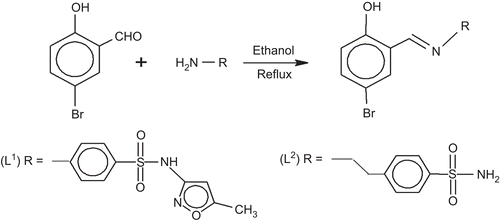
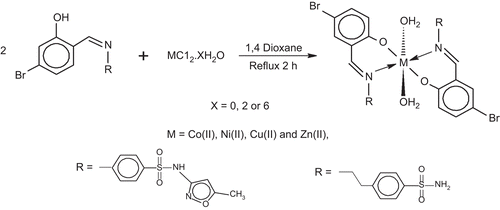
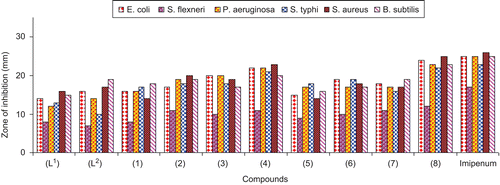
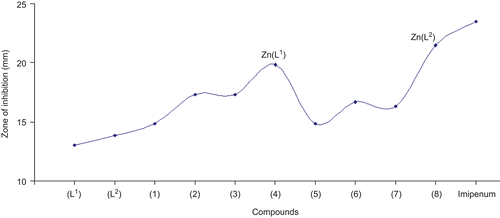
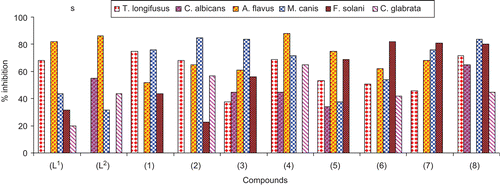
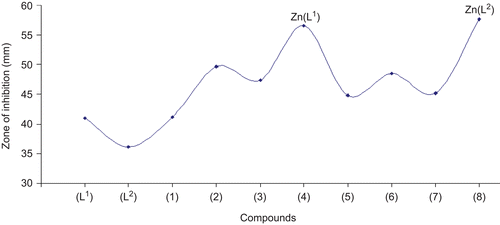
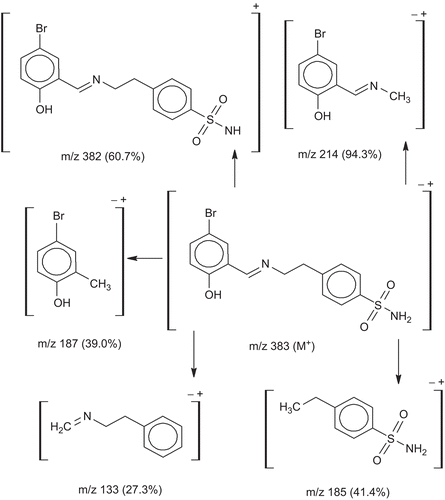
![Figure 6. The proposed fragmentation pattern of complex [Cu(L2-H)2(H2O)2].](/cms/asset/9d1183ff-4453-4e62-8518-2abec7f97031/ienz_a_574623_f0008_b.gif)